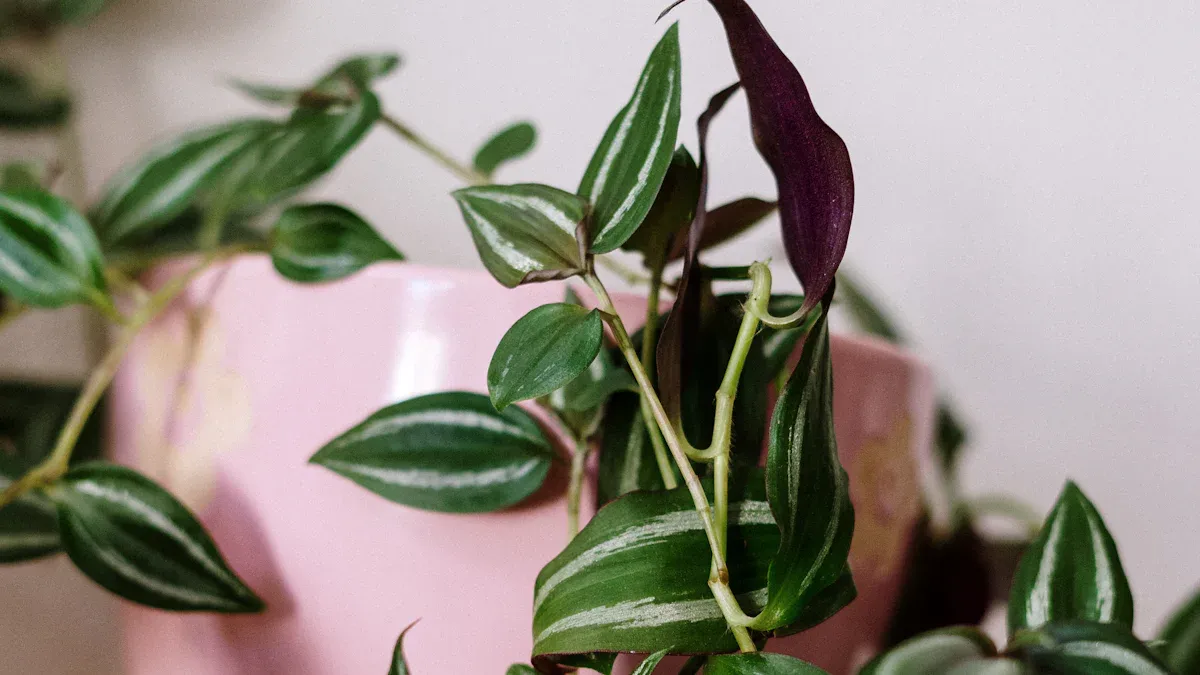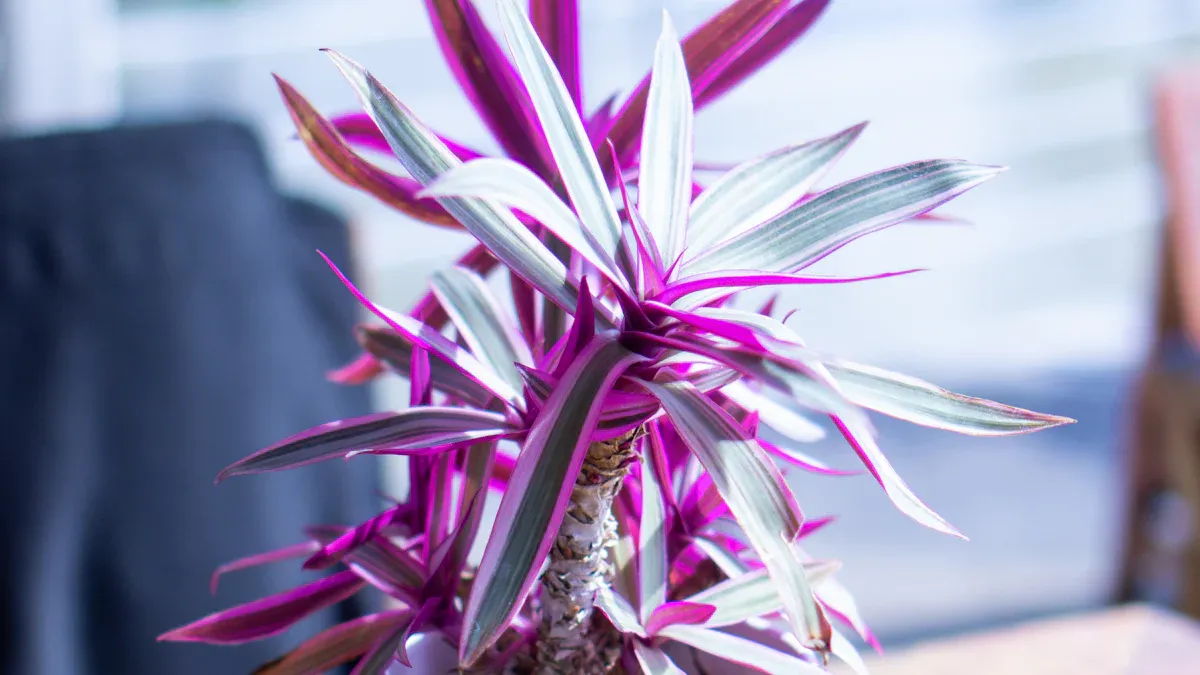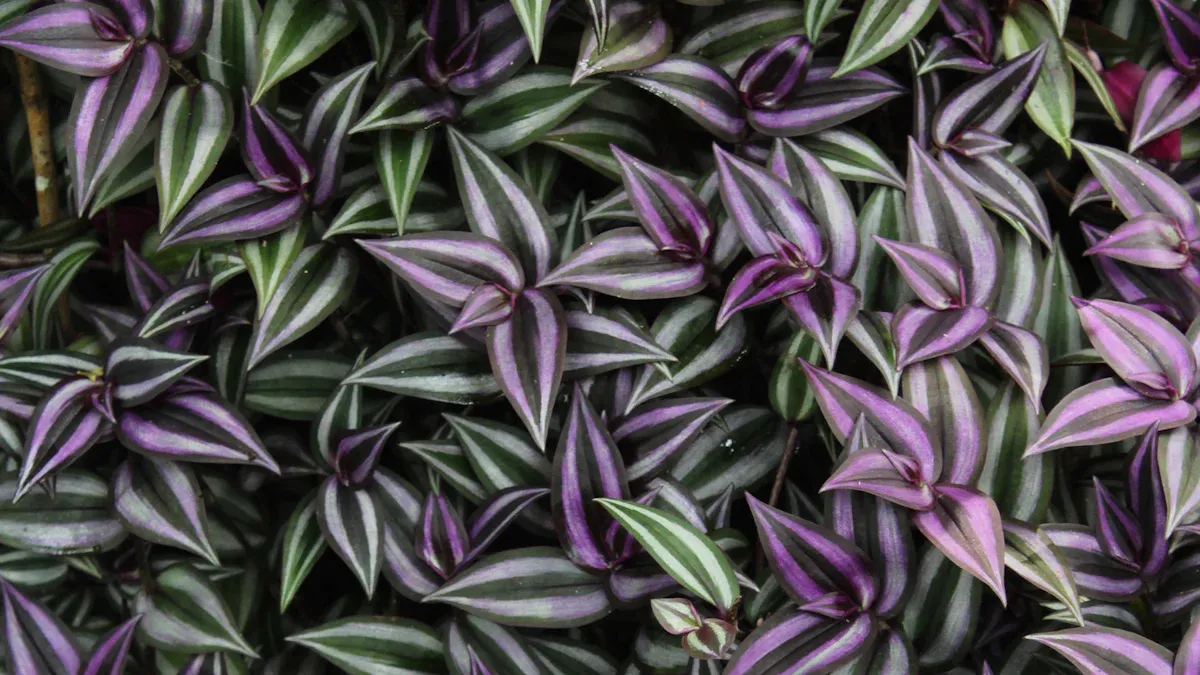
If you notice your Tradescantia plant leaves turning yellow, it often signals issues like overwatering or nutrient deficiencies. Understanding these signs is crucial for maintaining your plant’s health. Yellowing leaves can lead to nutrient imbalances, environmental stress, and hinder your plant’s overall vitality.
Impact of Yellowing Leaves | Description |
|---|---|
Nutrient Imbalances | Yellowing indicates nutrient deficiencies, leading to slowed growth or plant death if unaddressed. |
Environmental Stress | Yellowing can be a symptom of stress, affecting chlorophyll production and overall vitality. |
Recovery Potential | Correcting nutrient issues can stop further yellowing, but existing yellowed leaves won’t revert to green. |
Key Takeaways
Yellowing leaves on your Tradescantia often indicate overwatering or nutrient deficiencies. Check soil moisture before watering to prevent root rot.
Nutrient deficiencies, especially in nitrogen, magnesium, and iron, can cause yellowing. Use a balanced fertilizer to restore nutrients, but avoid over-fertilizing.
Natural aging can lead to yellow leaves, especially in older foliage. Monitor your plant’s overall health to distinguish between normal aging and stress.
Causes of Yellowing

Overwatering
Overwatering is one of the most common reasons your Tradescantia plant leaves might turn yellow. When you give your plant too much water, it can lead to root rot. This condition occurs when the roots sit in soggy soil, preventing them from absorbing nutrients properly. You might notice that the leaves droop and turn yellow, especially the younger ones.
To avoid this, always check the soil moisture before watering. A good rule of thumb is to wait until the top 50% of the soil is dry. If you see water pooling in the pot or a catch plate underneath, it’s time to discard that excess water. Remember, your Tradescantia doesn’t need to be drenched; it thrives best when you allow the soil to dry out between waterings.
Tip: If you notice yellow leaves, check the pot’s weight. If it feels heavy, hold off on watering for a bit!
Nutrient Deficiencies
Nutrient deficiencies can also cause your Tradescantia plant leaves to yellow. The most common culprits are nitrogen, magnesium, and iron. Each of these nutrients plays a vital role in your plant’s health. For instance, nitrogen is essential for chlorophyll production, which keeps your leaves green. When nitrogen is lacking, you might see yellowing starting from the lower leaves and moving upwards.
Here’s a quick look at the visual symptoms of nutrient deficiencies:
Nutrient | Visual Symptoms |
|---|---|
Nitrogen | – Yellowed lower foliage, curled tips, and stunted growth. |
Magnesium | – Interveinal chlorosis and brown spots on older leaves. |
Iron | – Yellowing of new leaves and slowed growth. |
If you suspect a nutrient deficiency, consider using a balanced fertilizer. This can help restore the nutrients your Tradescantia needs to thrive. Just be careful not to over-fertilize, as this can lead to its own set of problems, including yellowing leaves.
Natural Aging
Lastly, natural aging is a normal process that can lead to yellowing leaves. As your Tradescantia grows, it prioritizes energy for new leaf production. This means older leaves may start to yellow and eventually drop off.
You might notice this happening more frequently as your plant matures. While some yellowing is perfectly normal, if you see yellowing in younger leaves, it could indicate stress or care issues.
Note: A single yellow leaf may be a sign of aging, but multiple yellow leaves could suggest a problem. Keep an eye on your plant’s overall health!
Signs of Stress in Tradescantia Plant Leaves

Yellow Edges
If you notice yellow edges on your Tradescantia plant leaves, it’s a sign that your plant is stressed. This condition often arises from over-fertilization or inconsistent watering. When you give your plant too much fertilizer, it can lead to a buildup of salts in the soil. These salts can burn the leaf edges, causing them to turn yellow and crispy.
Here are some common signs of stress you should look for:
Curling leaves
Yellowing leaves
Brown crispy leaf tips
Leaves losing variegation
Black or brown spots on the leaves
Signs of plant pests
To help your Tradescantia recover, consider flushing the soil with water to remove excess salts. Make sure to adjust your fertilization routine, using a balanced fertilizer at the recommended rate. Regular inspections every couple of weeks can help you catch these issues early, ensuring your plant stays healthy and vibrant.
Root Rot
Root rot is another serious issue that can cause your Tradescantia plant leaves to yellow. This condition occurs when the roots sit in waterlogged soil, leading to mushy roots and a lack of oxygen. Early symptoms of root rot include yellowing leaves and mushy roots. You might also notice that your plant wilts, even if you’ve watered it adequately. This wilting is a clear indicator that something is wrong.
Here are some common signs of root rot:
Wilting and yellowing leaves, particularly in the oldest leaves
A plant that continues to wilt despite adequate watering
Leaves may brown, die, and eventually fall off if left untreated
If you suspect root rot, act quickly! Here’s what you can do:
Remove the indoor plant from the pot.
Cut away any rotting roots with clean scissors or a knife.
Prune the plant to restore balance with the remaining roots.
Repot the plant in fresh soil to prevent recurrence.
Consider sterilizing the pot and soil to eliminate any lingering pathogens. Treating the roots with fungicide can also help. Regularly monitoring your Tradescantia for signs of stress, such as yellowing leaves or unusual spots, will keep your plant thriving.
In summary, yellowing leaves on your Tradescantia can stem from overwatering, nutrient deficiencies, or natural aging. To keep your plant healthy, let the soil dry out completely before watering. Provide a few hours of direct sunlight daily and feed with a balanced fertilizer every four weeks. With these tips, your Tradescantia will thrive! 🌱
FAQ
What should I do if my Tradescantia leaves are yellowing?
Check your watering habits first. Adjust your watering schedule and consider fertilizing if nutrient deficiencies are suspected.
How often should I water my Tradescantia?
Water your Tradescantia when the top 50% of the soil feels dry. This helps prevent overwatering.
Can I save my Tradescantia if it has root rot?
Yes! Remove the plant from its pot, trim away rotten roots, and repot in fresh soil.

